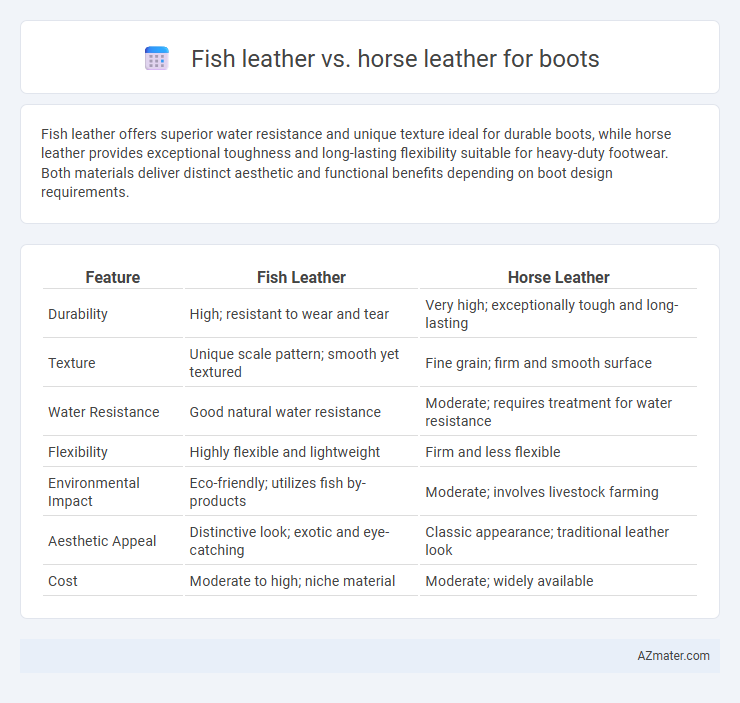Fish leather offers superior water resistance and unique texture ideal for durable boots, while horse leather provides exceptional toughness and long-lasting flexibility suitable for heavy-duty footwear. Both materials deliver distinct aesthetic and functional benefits depending on boot design requirements.
Table of Comparison
| Feature | Fish Leather | Horse Leather |
|---|---|---|
| Durability | High; resistant to wear and tear | Very high; exceptionally tough and long-lasting |
| Texture | Unique scale pattern; smooth yet textured | Fine grain; firm and smooth surface |
| Water Resistance | Good natural water resistance | Moderate; requires treatment for water resistance |
| Flexibility | Highly flexible and lightweight | Firm and less flexible |
| Environmental Impact | Eco-friendly; utilizes fish by-products | Moderate; involves livestock farming |
| Aesthetic Appeal | Distinctive look; exotic and eye-catching | Classic appearance; traditional leather look |
| Cost | Moderate to high; niche material | Moderate; widely available |
Introduction: Fish Leather vs Horse Leather Boots
Fish leather offers a unique combination of lightweight durability and striking texture, making it a distinctive choice for boot manufacturing. Horse leather is prized for its strength, flexibility, and classic aesthetic, often preferred for traditional work and riding boots. Comparing the two materials highlights differences in sustainability, tactile qualities, and long-term wear performance essential for informed boot selection.
Origin and Sustainability of Fish and Horse Leather
Fish leather originates primarily from species like salmon, carp, and cod, utilizing byproducts from the fishing industry, which promotes waste reduction and sustainable resource use. Horse leather, sourced mainly from retired or culled horses, often raises ethical and environmental concerns due to land and feed resource consumption associated with horse breeding. The sustainable advantage of fish leather lies in its lower ecological footprint and circular economy benefits, while horse leather's origin can impact its environmental sustainability depending on sourcing practices.
Leather Production Processes Compared
Fish leather production involves tanning fish skins, primarily from species like salmon or cod, using natural oils and enzymes to preserve flexibility and durability with less environmental impact. Horse leather, sourced from horsehide, undergoes traditional tanning methods including chrome or vegetable tanning, resulting in thicker, more rigid leather prized for strength and longevity. The tanning process for fish leather generally requires less water and chemicals, making it a more sustainable option compared to horse leather production.
Durability: Which Leather Lasts Longer?
Fish leather, particularly from species like salmon or cod, offers remarkable durability due to its unique fiber structure, which is often tougher and more tear-resistant than many traditional leathers. Horse leather, known for its density and strength, also provides excellent longevity, especially with proper tanning and care. When comparing durability, fish leather tends to resist abrasion and water damage better, making it a strong contender for long-lasting boot materials in harsh conditions.
Comfort and Breathability in Boots
Fish leather offers superior breathability and lightweight comfort compared to horse leather due to its natural porous structure, which enhances air circulation inside boots. Horse leather, while durable and firm, tends to be thicker and less breathable, potentially leading to reduced comfort during extended wear. Fish leather's unique texture provides a softer, more flexible fit, making it an excellent choice for boots prioritizing comfort and moisture management.
Aesthetic Appeal: Texture and Color Options
Fish leather offers a unique texture characterized by natural scale patterns that create a distinctive, eye-catching surface, whereas horse leather typically features a smooth, dense grain with a more traditional, polished appearance. Fish leather provides a range of vibrant color options due to its ability to absorb dyes deeply, resulting in vivid, exotic hues ideal for bold boot designs. Horse leather tends to maintain classic, earthy tones that appeal to those seeking timeless, versatile footwear aesthetics.
Waterproof Qualities and Maintenance Needs
Fish leather boasts superior waterproof qualities compared to horse leather due to its dense, natural fiber structure, making it highly resistant to water penetration. Maintenance for fish leather involves regular cleaning with a damp cloth and occasional moisturizing to preserve flexibility and prevent cracking. Horse leather, while durable and water-resistant to some extent, requires more frequent conditioning and waterproofing treatments to maintain its integrity and prevent moisture damage over time.
Environmental Impact and Ethical Considerations
Fish leather for boots offers a lower environmental impact due to its use of byproducts from the fishing industry, reducing waste and minimizing resource consumption compared to horse leather, which involves dedicated livestock farming with higher greenhouse gas emissions. Ethical considerations favor fish leather as it typically utilizes skins that would otherwise be discarded, whereas horse leather raises concerns about animal welfare and the conditions of horses bred or raised for leather production. The biodegradable nature of fish leather further supports sustainability goals, contrasting with the more resource-intensive and ethically complex process required for horse leather.
Price Differences and Market Availability
Fish leather typically costs 30-50% less than horse leather due to lower processing expenses and abundant raw material supply from fish industry byproducts. Horse leather remains pricier and less common in the market, mainly because of limited availability and longer curing times. While fish leather gains popularity for sustainable and affordable footwear, horse leather maintains a niche market with premium pricing for luxury boots.
Choosing the Right Leather for Your Boots
Fish leather offers exceptional durability, water resistance, and a unique textured appearance, making it ideal for stylish, eco-friendly boots. Horse leather provides classic strength, flexibility, and breathability, favored for traditional boot construction and long-lasting comfort. Choosing the right leather depends on your preference for sustainability and aesthetics with fish leather or proven resilience and comfort with horse leather.

Infographic: Fish leather vs Horse leather for Boot
 azmater.com
azmater.com